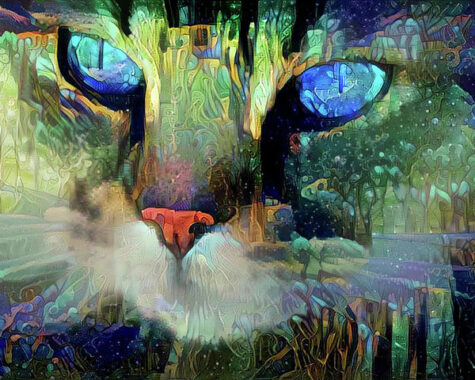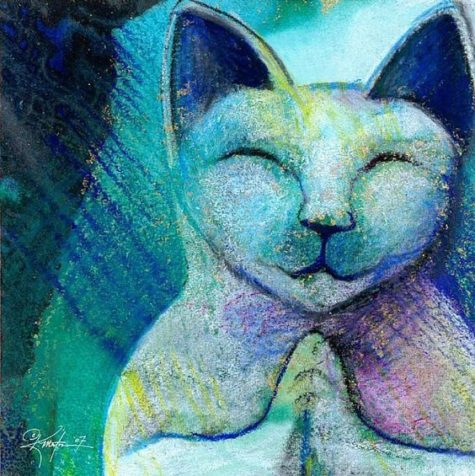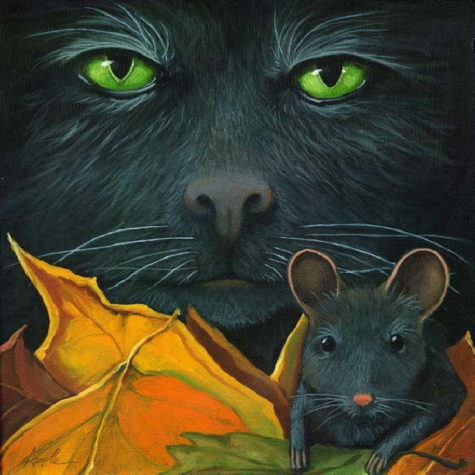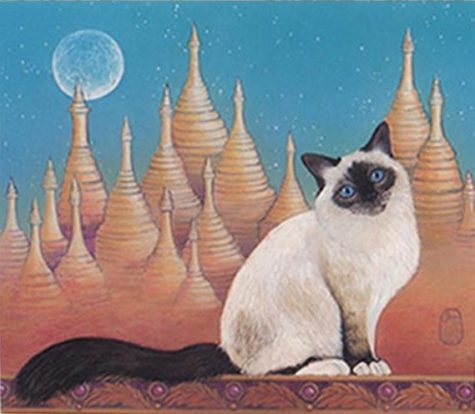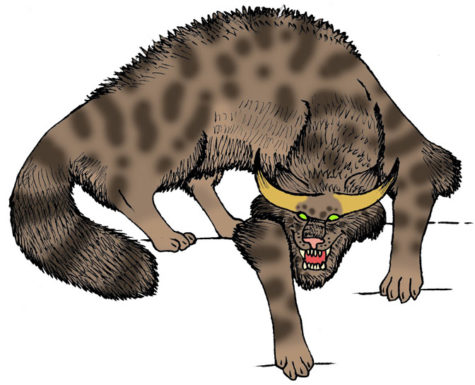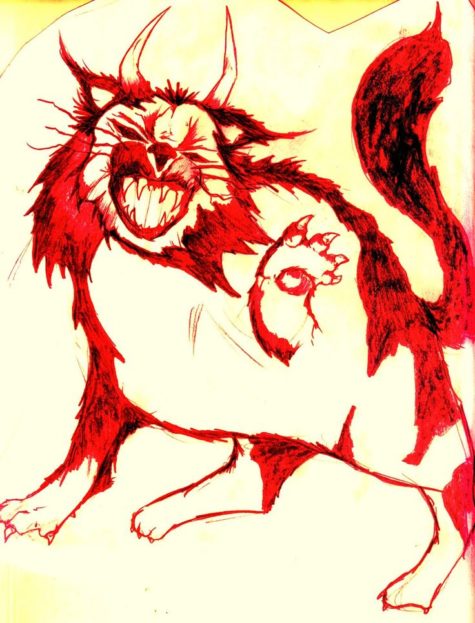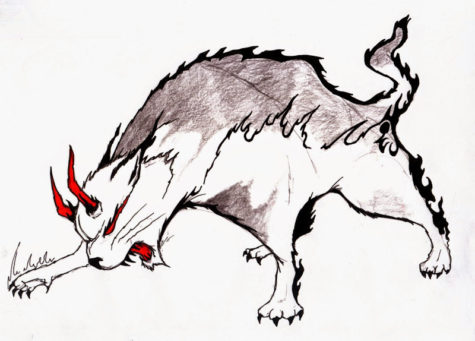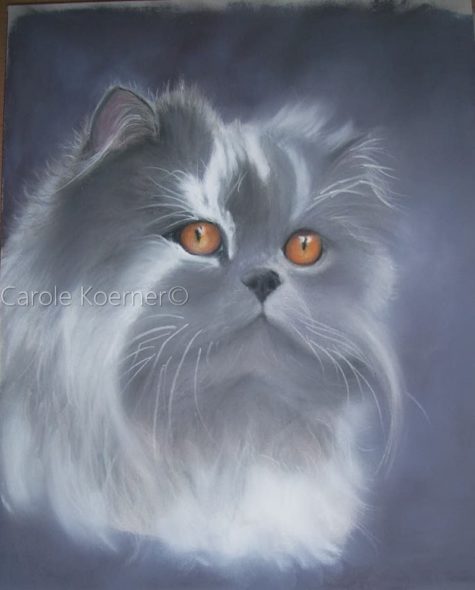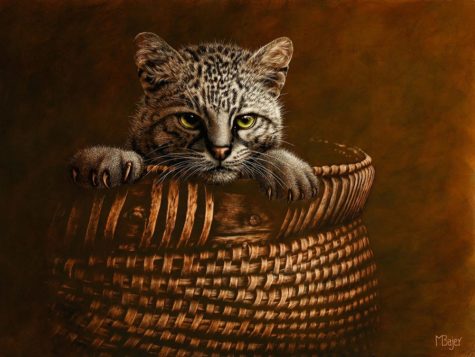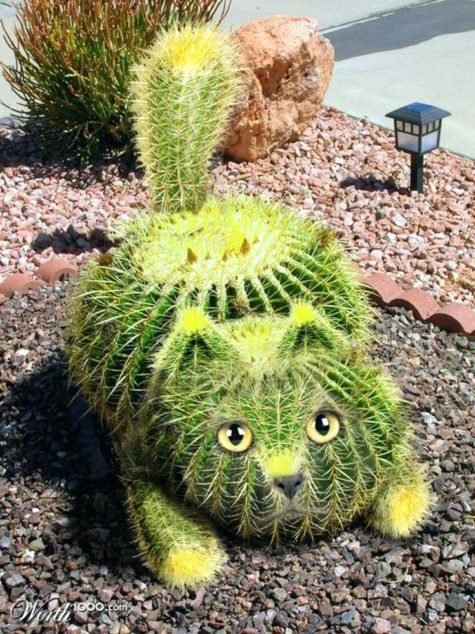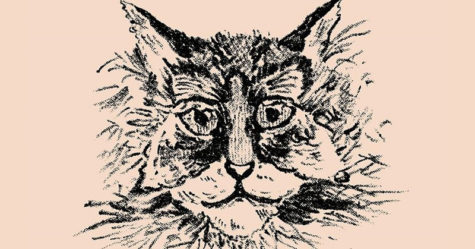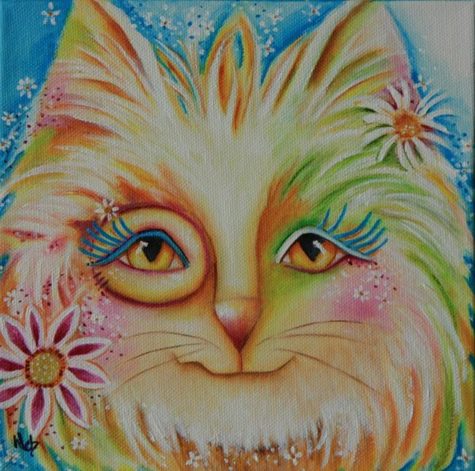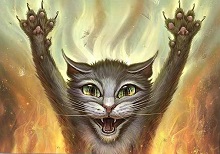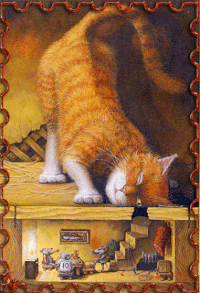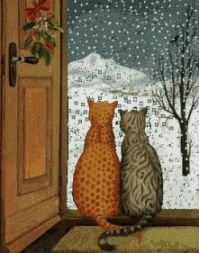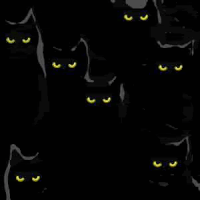Mythological Cats
Mau Comes Into Being
There was a day when darkness gathered itself into a hungry snake and crawled upon the earth. On her belly she crept toward the city of light, swallowing whatever lay in her path: Men and women, beasts, vegetables and Gods. And no thing that touched her lips escaped her, for all matter was lost in the darkness.
That was the day, or rather the night, that Ra left the sky and took his shape in the cat. To fool the snake, he slept under the leathery leaves of the laurel, holding in his strength, stirring only once for a single languid lick of his paws to brush against his whiskers.
Seeing the cat ~ that tasty bit of flesh, the snake slithered over and opened its mouth. On the other side of her teeth swelled the void, the abyss, the great nothing, and from it issued the cries of all the lost things of creation. Their voices were a wailing wind that beckoned from the darkness.
Then the soul of Ra in the form of a tiny cat leapt up beneath the shade of the laurel and, with teeth of iron and gold, he snapped off the head of the snake and sliced its body into a thousand pieces and swallowed them up.
Blood from the snake’s mouth spilled onto the ground. In that manner Ra’s creations returned to earth. The blood seeped into the ground and was taken up by the thirsty laurel, which burst into bloom with the souls of the dead in the shape of yellow flowers.
Now leaning down from the east edge of heaven, the God of words had witnessed the battle. He had felt each puncture of the snake’s teeth upon his own throat and praised the cat which had given its shape to Ra.
“How like the God that made him is the radiant cat. How he slew the darkness with his mouth!” And Mau became the cat’s name and the God gave him words of power.
~From Awakening Osiris
The Famous Patripatan
In India, the cat is recognized as a magical bringer of luck and there is the legend of the famous Patripatan.
This cat was so cunning and so softly insidious that when he once climbed into the land of Devendiren in the sky (where, as we all know, there reigned twenty-four million gods and forty-eight million goddesses) in order to plead his master’s cause, he became the friend of the all-powerful king of the gods and the beloved confidant of the most beautiful of the goddesses.
He did so much and so well that for three hundred years he forgot to come down again to the earth.
And while the prince and the inhabitants of the kingdom of Salangham awaited his return, not a person aged by a single hour during all the hours and days and years that passed. At last Patripatan returned. In his white paws he brought a complete and heavy branch of that rarest talisman-flower of Parasidam, in full flower. And from that day there was nothing but gentleness and beauty in that kingdom.
Found at: Moggycats Cat Pages
The Cat and The Rat
The cat has always and everywhere been the rat’s enemy, and according to Madagascan legend it was the rat who started it.
Once upon a time the cat and the rat lived in peace. One day, however, a great famine overtook them. There was nothing to eat, so they set off for a more fertile country. On the journey they came to the banks of a river too wide for them to swim across. Finding no driftwood to use as a raft, they dug up an enormous yam. The rat set to and hollowed it out with his teeth, making a canoe.
When the boat was ready they embarked, the cat paddling and the rat navigating from the stern. But the rat, having been born with an eternal hunger, soon began to eat the edges of the yam. The cat knew nothing of this until the canoe shipped water and began to sink. Then, too late, he realized that the rat had foolishly put both their lives in danger. He meditated on revenge. In the water the rat, weak with hunger and fatigue and about to drown, begged the cat for help.
“I will only help you,” said the cat, “if you agree to let me eat you when we reach land.”
Always having a trick in reserve, the cunning rat consented. When they reached the bank the rat said to the cat, “Wait till I am dry. While I am saturated you will not find me good to eat.” The cat believed him, and the rat used the delay to dig out a hole among some tree roots and hide. “Now I am dry,” he cried.
In vain the cat struggled, digging furiously, but the rat was safely out of reach deep in the earth. And so it was that the rat escaped and that the entire race of cats, duped, declared eternal war on the entire race of rats.
Found at: Moggycats Cat Pages
The Sacred Cat of Burma
The sacred cat of Burma is not, as some might suppose, the Burmese, but is a breed known in the west as the Birman. A charming legend accompanies the Birman cat.
Many years ago, in a temple built on the side of the mountain of Lugh, there lived in prayer the very venerable Kittah Mun Ha, the great Lama precious amongst the precious, whose golden beard had been plaited by the god Song Hio himself. There was not one minute, not one look, not one thought of his existence that was not consecrated to the adoration, the contemplation, the pious service of Tsun Kyankze, the goddess with the eyes of sapphire. She presided over the transmigration of souls, which allows a Kittah to relive the span of his animal existence in the body of a sacred animal before he takes up a body haloed in the total perfection and holiness of the great priests.
Sitting in meditation beside Mun Ha was Sinh, his beloved oracle, a cat quite white with eyes of yellow, a yellow that reflected the golden beard of his master and the golden body of the goddess whose eyes were the color of the sky . . . Sinh, the counselor, whose ears, tail, nose and paws were the color of soil, a sign of the taint and impurity in everything that touches or can touch the earth.
Now, one evening, while a malevolent moon was permitting the enemy from Siam to approach the sacred place, the great priest Mun Ha entered softly into the state of death, with his divine cat at his side and under the despairing eyes of his overwhelmed Kittahs. it was then that the miracle took place . . . the unique miracle of the immediate transmigration.
With one bound, Sinh was on the golden throne, perched on the head of his departed master. He arched himself up on this head which, for the first time, no longer contemplated the goddess. And Sinh also became spellbound before the eternal statue, and the bristling hairs on his white spine suddenly become the yellow of gold. And his golden eyes became blue, huge and profound like the eyes of the goddess.
And as he turned his head gently towards the South door, his four paws, touching the venerable skull, became a blinding white. And as his eyes stared at the Southern door, the Kittahs obeyed the expression in the eyes that were charged with hardness and with light. They threw themselves against the heavy bronze doors and against the first of the invaders.
The temple was saved from profanation and pillage. Sinh, however, had not left the throne. He did not move for seven days, but on the seventh day, steadily facing the goddess and with his eyes on her eyes, he died, hieratic and mysterious, carrying towards Tsun Kiankze the soul of Mun Ha, from then on too perfect for this earth. And when, seven days later, the priests gathered before the statue to consult among themselves on the succession to Mun Ha, all the cats of the temple came running – and all were clothed in gold and gloved in white, and the yellow of all those eyes had been changed to a deep sapphire blue. In silence they all surrounded the youngest of the Kittahs, who was designated in this way by the will of the goddess.
‘From that day, if a sacred cat should die in the temple of Lao-Tsun, it is the soul of a Kittah that takes its place for ever in the paradise of Song Hio, and the golden god.
Found at: Moggycats Cat Pages
Horned Demon Cat
Found in Cats of Magic, Mythology, and Mystery, this is reputed to be a true story of the Horned Demon Cat of World War II.
It could have been a scene enacted from Dante’s ‘Inferno’ – even the clouds seemed to be wreathed in flames as torrent after torrent of plummeting German bombs screamed through the darkened skies over south London, and danced a fiery tarantella of death upon its shuddering streets, like a flurry of shrieking souls in everlasting torment. And in the midst of this panorama of pandemonium was Howard Leland – one of many volunteers with the ARP (Air Raid Precautions) who had been boldly defying the deadly rain of missiles throughout that fearful evening in October 1943 in a desperate bid to minimize its malevolent effects. Little did Leland realize, however, that he would soon encounter something infinitely more sinister, and malign, than anything conjured forth by the wartime enemy.
As the ground reverberated from the intensity of yet another mighty explosion nearby, Leland ran into a deserted house to take shelter, until the immediate danger had passed. The building’s interior was pitch-black, but with the aid of his torch he located a staircase, and rested on the bottom step for a while, waiting for this latest airborne assault to end.
Suddenly, a cold shadow of fear swept across him, for as he sat there he realised – indefinably but undeniably – that he was no longer alone in that house. Something – not someone – else was here too, close by, and watching him. Unbidden, his eyes gazed upwards, to the top of the stairs, and the feeling intensified. Surely there, concealed amid the stygian gloom, was the source of his fear – and now he would reveal its identity.
Leland switched on his torch again, directing its penetrating beam onto the topmost stair – and beheld a hellish sight that transfixed him with fear, expelling from his mind all of that evening’s previous horrors in an instant. Crouched upon the stair was a huge hairy beast with tabby-like stripes of black and brown, clawed paws, and blazing eyes like glowed like twin infernos, mesmerizing Leland with their incandescent gaze. It would have resembled a monstrous cat – had it not been for the pair of sharp pointed horns that protruded from its skull!
For almost a minute, Leland remained motionless, held in thrall by the cold aura of palpable evil that radiated inexorably from the beast’s unblinking eyes – and then it moved! With a single colossal leap, it sprang from the stair, plunging down into the shadowy room – but before it reached the ground, it had vanished. Yet its presence had not entirely gone – for Leland could plainly hear a spine-chilling yowling cry, echoing in the empty room.
At that same instant, however, the sound of human footsteps came from the open front door – and the spell was broken. The eldritch cries ceased immediately, and through the door walked two of Leland’s ARP comrades. Their reassuringly familiar forms and voices swiftly dispersed the shroud of terror that had encompassed Leland only moments before, and encouraged him to recount his chilling experience. Neither of his friends had heard anything when entering the house, however, so he did not expect them to treat his account seriously – which is why he was so surprised when they listened silently and with grave expressions throughout his story, making no attempt to scoff or scorn his words.
When Leland had finished, his friends informed him that he was not the first person to have spied the feline monster. On the contrary, it had been seen by many different eyewitnesses over a period of several years, and the sightings were always the same – an immense horned cat with demonic eyes, squatting at the top of the stairs.
Nevertheless, in the hope that a more straightforward explanation may be forthcoming, the three men walked up the stairs and searched everywhere thoroughly for any physical evidence of the creature’s reality, but nothing was found.
Still disturbed by the memory of this grotesque entity but anxious to uncover its identity and possible significance, two days later Leland visited a renowned clairvoyant, John Pendragon, and recalled to him his encounter. After listening intently, Pendragon located the house on a large map of London, then placed a forefinger on the precise spot marking it.
At once, Pendragon’s mind was filled with a whirling vista of cats – countless furry wraiths swirling all around at the top of the deserted house’s stairs in a screeching, spitting vortex of feline fury, a mad maelstrom of undying hate. And at its very centre was something much larger, but it was not a cat – not even a horned demon cat. It was a man – haggard and despairing, with a noose in his hand, about to place it around his own neck.
After describing this vision to Leland, Pendragon asked him to make enquiries among the house’s neighbours, to discover whether any details of its history and of its previous owners corresponded with those in his vision. A week later, Leland returned, bearing some extremely interesting (and vindicating) news.
One of the house’s former inhabitants had been an ardent practitioner of the black arts, in the vain hope of improving what he had perceived to be a wretched, unfulfilled life. In accordance with one particularly grisly ritual, he had routinely slaughtered numerous cats for sacrifice upon an unholy altar. Ultimately, the balance of his mind had become totally unhinged, and he had committed suicide – hanging himself with a noose, suspended from the banister at the top of the stairs. Shortly afterwards, the great horned cat was seen there for the first time, and spectral yowling cries have often been heard since too.
Was the horned demon cat an elemental?
When Leland asked his opinion as to this monster’s precise nature, Pendragon suggested that it was probably an elemental spirit – one whose feline appearance and vitriolic hatred had been created by the restless ghosts of the departed sorcerer’s many feline victims, and which would linger indefinitely in the grim locality where they had all met their terrible deaths.
Although the vast majority of Britain’s mystery cats are unquestionably exotic non-native cats that have escaped or have been deliberately released from captivity, or are simple misidentifications of common animals, some investigators have speculated whether a few of them may in reality be paranormal (zooform) entities ‘disguised’ as big cats – as would certainly seem to have been the case with London’s horned demon cat of World War Two.
Incidentally, it should be noted here that although the original source of this case was John Pendragon’s autobiography, Pendragon (1968), which was written in collaboration with paranormal mysteries writer-investigator Brad Steiger, it only contained a fairly brief account of events. However, Steiger’s own book, Bizarre Cats (1993), included a much more detailed, greatly expanded version as related to him by Pendragon, which not only emphasized the entity’s feline nature but also incorporated other noteworthy additional information – such as the full name of the eyewitness (merely referred to by his initials in Pendragon’s book), and the hideous cat-slaying rituals performed by the man who had subsequently committed suicide in the house where the horned demon cat was later seen.
Where The Persian Cat Came From
Once upon a time there was a great Persian hero called Rustem, who was a brave fighter and did many great deeds. One night, Rustem saved a magician from some robbers who had set upon the man suddenly in a lonely place. It being too dark for the magician to return to his own home, Rustem invited the old man to spend the night in his tent and to dine with him.
After supper Rustem and the magician sat outside the tent in the cool air and watched a big fire which Rustem’s retainers had lit to keep out the night-time chill. It was a clear, starlit night and a quick little breeze fluttered the smoke of the fire so that it danced and whirled about above the flames. The stars seemed to dance with the smoke, glittering and gleaming between the shapes and eddies. Here and there a little tongue of darting flame joined in the dance too.
After a while the magician spoke to Rustem. “I should like to make you a gift in return for what you have done for me. Tell me what beautiful thing you most desire and I will make it so.”
However Rustem was a man of deeds who had no great desire for material things. “There is nothing that I desire,” he said, “when I look around me there is more than enough beauty for me to enjoy. At the moment, what could be more beautiful than that smoke and the fire and the stars?”
“In that case, I will make a gift for you out of the smoke and the flame and the stars,” said the magician.
Rustem watched in awe as the magician took a handful of smoke and a flame of fire and two bright stars and kneaded them together for a minute.
At last the magician sat back and opened his hands and said, “Rustem, here is my gift to you.”
Rustem was delighted, for the magician had made a little live creature with long, soft, smoke-grey fur and bright, star-like eyes and with a little red tongue like a tiny flame of fire. The creature danced and capered about, and was a joy to look upon.
“Take it home,” said the magician. “It will be a companion for your children and an ornament for your house.”
Rustem took the kitten home with him and it brought great joy to his household. And that was how the first Persian kitten came into the world.
Found at: Moggycats Cat Pages
How Cats Came To Live With The Hopi
A long time ago a Hopi boy went out to hunt. It was winter and the snow lay on the ground in the valley where he searched for game. To his surprise he found some tracks in it that were like no tracks he had ever seen before, and he followed them. The tracks led out of the valley and ended at a large rock.
The boy put his hand into the opening under the rock and pulled out a strange animal by its leg. He tied its legs together and started back with it to his village. When he reached home, he asked his father what the animal was. The boy’s father replied that it was a cat and that it ate mice, rats and rabbits.
On hearing this, the boy went back into the valley and caught a rabbit which he brought back to the cat. He kept the cat confined in a niche in the wall of his home and continued to feed it for four days. In this way the cat became tame and cats have lived in Hopi houses ever since.
Found at: Moggycats Cat Pages
The Cactus Cat
By William T Cox, from “Fearsome Creatures of the Lumberwoods, with a Few Desert and Mountain Beasts,” published in 1910, we have this description of the Splinter Cat, (Cactifelinus Inebrius).
How many people have heard of the cactus cat? Thousands of people spend their winters in the great Southwest – the land of desert and mountain, of fruitful valleys, of flat-topped mesas, of Pueblos, Navajos, and Apaches, of sunshine, and the ruins of ancient “Cliff-dwellers.” It is doubtful, however, if one in a hundred of these people ever heard of a cactus cat, to say nothing of seeing one sporting about among the cholla and palo verde. Only the oldtimers know of the beast and its queer habits.
The cactus cat, as its name signifies, lives in the great cactus districts, and is particularly abundant between Prescott and Tucson. It has been reported, also, from the valley of the lower Yaqui, in Old Mexico, and the cholla-covered hills of Yucatan.
The cactus cat has thorny hair, the thorns being especially long and rigid on its ears. Its tail is branched and upon the forearms above its front feet are sharp, knifelike blades of bone. With these blades it slashes the base of giant cactus trees, causing the sap to exude. This is done systematically, many trees being slashed in the course of several nights as the cat makes a big circuit.
By the time it is back to the place of beginning, the sap of the first cactus has fermented into a kind of mescal, sweet and very intoxicating. This is greedily lapped up by the thirsty beast, which soon becomes fiddling drunk, and goes waltzing off in the moonlight, rasping its bony forearms across each other and screaming with delight.
The Splinter Cat
By William T Cox, from “Fearsome Creatures of the Lumberwoods, with a Few Desert and Mountain Beasts,” published in 1910, we have this description of the Splinter Cat, (Felynx Arbordiffisus).
A widely distributed and frightfully destructive animal is the splinter cat. It is found from the Great Lakes to the Gulf, and eastward to the Atlantic Ocean, but in the Rocky Mountains has been reported from only a few localities.
Apparently the splinter cat inhabits that part of the country in which wild bees and raccoons abound. These are its natural food, and the animal puts in every dark and stormy night shattering trees in search of coons or honey. It doesn’t use any judgement in selecting coon trees or bee trees, but just smashes one tree after another until a hollow one containing food is found.
The method used by this animal in its destructive work is simple but effective. It climbs one tree, and from the uppermost branches bounds down and across toward the tree it wishes to destroy. Striking squarely with its hard face, the splinter cat passes right on, leaving the tree broken and shattered as though struck by lightning or snapped off by the wind.
Appalling destruction has been wrought by this animal in the Gulf States, where its work in the shape of a wrecked forest is often ascribed to windstorms.
An Ancient Chinese Cat Myth
When the world was a new-created place, the gods decided to appoint one creature to see that it ran smoothly and to oversee all other creatures. The creature they selected was the cat. Thoughtful and contemplative, cats were given the power of speech in order to talk with the creator gods and give instructions to the other creatures who shared the world. For a long time all seemed to go well.
Cats, however, were sybaritic creatures. Rather than attend to the mundane, day-to-day running of a world, they wanted to doze in sunbeams on beds of fragrant catnip and matatabi vine. The creator gods saw this and asked the cats whether they were doing anything to ensure the smooth running of this newly made world.
“Running a world is not of great interest to us,” said the cats, “we are content to roll on the grass and chase butterflies when the mood takes us. Mostly we let the world run itself so that we can enjoy the simple pleasures of warm sunshine and fresh, scented air.”
The gods asked the cats to be more diligent in the running of the newly made world and the cats promised to pay a little more attention to their allotted task. Some while later, the gods paid another visit to their vibrant new world and they found the cats sleeping under cherry trees or playing with falling cherry blossoms. Once more they questioned the cats’ dedication to overseeing the world.
“Running a world is, to be honest, a rather boring task. It is much more fun to sleep comfortably under cherry trees and frolic among the falling blossom,” said the cats, “however, we will try to pay more attention to the business of being in charge of the world – it is a great responsibility.”
The gods chastised the cats a second time and went away full of hope that the cats would pay closer attention to the running of the world the gods had given them. However, on a third visit, the gods found the cats chasing floating thistledown in the late summer sunshine.
“To be perfectly honest,” the cats said, “we’ve realised that we really don’t want the bother of running a world. We’ve noticed that one of your creatures shows much more promise in this respect, perhaps you could give the task of running a world to them so that we can spend our time enjoying the pleasures this world has to offer.”
The gods reluctantly agreed, but on one condition. Those appointed to run the world required the power of speech. Therefore cats would no longer be able to talk and the other creature, called humans, would be endowed with speech. And while man busied himself about running the world and remaking it to his own liking and filling it with chatter, cats basked in scented sunshine with inscrutable expressions.
From that day on, mankind gained the power of speech while cats enjoyed the delights the world had to offer – sunshine, scents, textures and things to chase or play with. But the gods never forgot that the cat was their first chosen one to run the world and made them timekeepers so that humans could always tell the time of day by looking into a cat’s eyes. In the morning their eyes are pools of blackness rimmed with gold; at noon they are mere black slits on disks of gold while in the evening they open out into pools of blackness once more.
Not only that, the purring of the cat is the sound of the machinery moving the world around the heavens and should the cats cease to purr, the world would stand still in the sky and the seasons, and all of time, would come to an end. So while mankind has the day-to-day running of the world, the cat still remains its timekeeper and guardian which is why cats always look so inscrutable and so smug.
Found at: Moggycats Cat Pages
